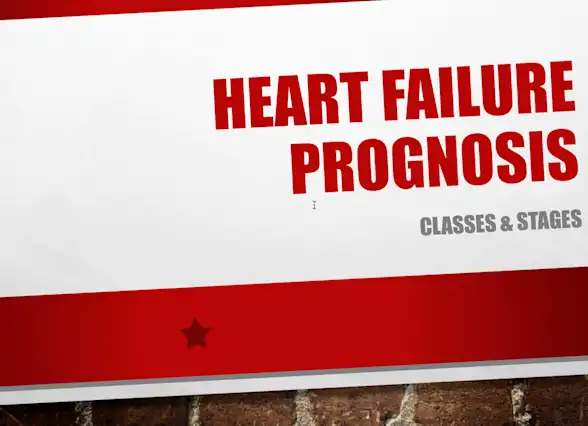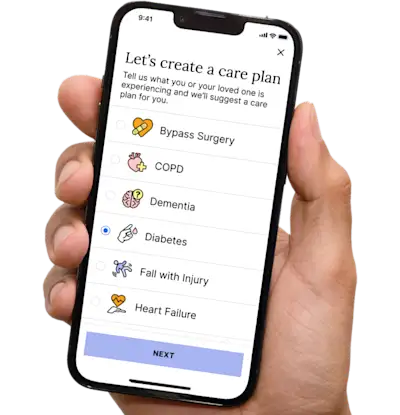The Classes and Stages of Heart Failure
Heart failure is categorized in two ways - classes and stages - based on physical symptoms and structural heart disease.
Get insurance benefits, legal documents, and medical records in one place

Helpful Highlights
Heart failure is categorized into four classes, 1-4.
Heart failure is also categorized into four stages, A-C.
The class and stage say a lot about the status of your loved one's heart failure and can guide what you can do to help.
What is heart failure?
A chronic (not curable), progressive (gets worse) condition in which the heart muscle is not able to pump enough blood to meet the body's demands for blood and oxygen. Heart failure occurs when it cannot pump (systolic) or fill (diastolic) adequately. This inadequacy often leads to an accumulation in other parts of the body, namely the lungs and lower extremities (feet, ankles, lower legs).
What is the prognosis for people with heart failure?
A prognosis is the likely course of a disease or ailment, including short-term and long-term outlooks and expectations. The prognosis for heart failure varies widely and depends on whether the underlying cause can be treated. The prognosis accounts for several factors:
Heart failure cause and severity
How quickly care is received
Overall health and response to treatment
Commitment to heart-healthy living
How can I help my loved one?
Be vigilant and keep providers informed, especially if symptoms worsen
Talk often, openly, and frankly with your loved one about their experiences
Stay positive and encourage your loved one to stay on their treatment plan
Classes of heart failure
Classes are defined by the New York Heart Association (NYHA).
Class 1. A person has no adverse symptoms and no limitation of physical activity.
Class 2. A person has mild symptoms and a slight limitation of physical activity but is comfortable doing ordinary activities.
Class 3. A person has significant symptoms and marked limitation of physical activity and is comfortable only at rest.
Class 4. A person has severe symptoms and cannot engage in physical activity without discomfort, and experiences symptoms even at rest.
Stages of heart failure
Stages of heart failure, which complement the classes, are defined by the American College of Cardiology (ACC) and the American Heart Association (AHA). The stages also come with recommendations for respective treatments.
Stage A. Stage A is considered pre-heart failure. A person is at high risk of developing heart failure but they have no structural heart disease or symptoms of heart failure.
Treatment recommendations: Quit smoking, exercise regularly, treat high blood pressure (hypertension), treat high cholesterol, discontinue alcohol or illegal drug use, and keep taking medications as prescribed for coronary artery disease, diabetes, or other cardiovascular conditions.
Stage B. Stage B is also considered pre-heart failure. A person has structural heart disease but still no symptoms of heart failure.
Treatment recommendations: Take an ACE-inhibitor (angiotensin-converting enzyme inhibitor) or ARB (angiotensin receptor blocker), beta-blockers should be prescribed in the event of a heart attack, and surgical options should be discussed for coronary artery or heart valve disease.
Stage C. Stage C is diagnosed heart failure. A person has structural heart disease and prior or current symptoms of heart failure.
Treatment recommendations: African Americans may be prescribed a hydralazine/nitrate combination if symptoms persist, diuretics ("water pills") and digoxin may be prescribed if symptoms persist, and aldosterone inhibitor may be prescribed with other therapies when symptoms remain severe, sodium (salt) intake restrictions, weight monitoring, fluid restrictions (only as prescribed), pacemaker or ICD (implantable cardioverter defibrillator) may be recommended.
Stage D. Stage D is refractory (doesn't respond to treatment) heart failure requiring specialized interventions. A person has advanced structural heart disease and persistent, significant to severe symptoms of heart failure. Stage D is commonly referred to as "end stage" heart failure.
Treatment recommendations: Evaluation for heart transplant, VAD (ventricular assist device), surgical options, research therapies, continuous infusion of inotropic drugs, palliative care, and hospice (end-of-life) care.
RESOURCES
American Heart Association (AHA) – Classes & Stages of Heart Failure
Caraballo, C., Desai, N.R., Mulder, H., Alhanti, B., Wilson, F.P., Fiuzat, M., et al. (2019). Clinical implications of the New York Heart Association classification. Journal of the American Heart Association, 8(23), e014240. doi: 10.1161/JAHA.119.014240
No content in this app, regardless of date, should ever be used as a substitute for direct medical advice from your doctor or other qualified clinician.
Get more support and guidance on insurance benefits, medical records and legal forms.
Helpful brings together your insurance benefits, legal documents, and medical records in one personalized place — so you always know what you have, and never have to search again.

Technology for Health Tasks. Mental Health for the Tough Stuff.
Helpful connects your medical records, insurance, and caregiving tasks automatically. And when you need more than logistics, a therapist is here to guide you.
In-Network and Covered
For Individuals, Couples and Families
HIPAA Compliant, Data Stays Private


Healthcare Tasks Simplified

From syncing records to spotting drug interactions, Helpful does the heavy lifting, turning complex health info into clear tasks and showing you benefits you can actually use, giving you clarity and control over your care.

In-Network Mental Health

Our licensed therapists are here to support you and your loved ones through stress, burnout, and life’s hardest moments, with an inclusive, compassionate approach that works with most insurance plans.

Create Legal Documents

Plan ahead by creating will, trusts, advance directives and more, that ensure your wishes are honored in the event you can’t speak for yourself -with Helpful guiding you every step of the way.